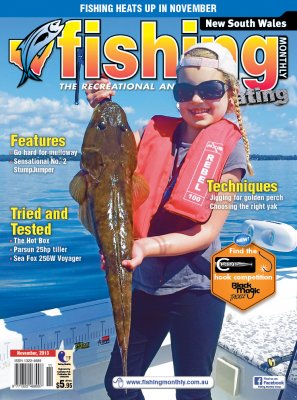Gold down below by CHRIS FRITH
 The concept of vertically jigging for golden perch has grown enormously in the past few years, largely due to the growth of competitive yellowbelly fishing in which anglers are constantly trying and refining new techniques.
The concept of vertically jigging for golden perch has grown enormously in the past few years, largely due to the growth of competitive yellowbelly fishing in which anglers are constantly trying and refining new techniques.
The popularity of vertical presentations is easily justified; in many situations it is simply the most effective method of catching yellowbelly.
Vertically jigging is the process of targeting specific populations of fish directly under you. It is especially effective on shut-down fish, allowing anglers to hold their offerings right in strike zone for extended periods.
There are a number of situations where this technique can be employed, such as targeting fish holding tight to timber, sitting in creek beds or feeding off bait-ball edges. These factors will dictate the lure and which of the two main techniques you should use.
BOTTOM TAPPING
This technique is best used for targeting fish holding tight to the bottom, particularly in the Summer when yellowbelly seek the cooler depths.
A quality sounder will allow you to identify fish holding in open water, on drop-offs or creek beds but it can still take a keen eye and well set-up unit to pinpoint bottom huggers.
For those without such luxuries, a 'hit and miss' approach on standing timber is hard to beat. The ideal depth will depend on the day, but I typically focus on 25'-35' during Summer and up to 13' when fishing cooler water.
Lipless crankbaits and blades are the weapons of choice for bottom tapping; something with a bit of weight that will maintain good bottom contact.
My preferred lures are Jackall Mask Vibes, TT Switchblades and Mazzy Vibes, although the new Atomic Semi Hardz Vib lures are sure to be a big hit on the yellowbelly scene.
Use darker colours when targeting deep fish; these will stand out the most where there is low visibility by creating a sharp silhouette. Black and purple patterns are great deep-water performers; when targeting shallower depths natural colours are my mainstay.
Once you have found likely-looking water, simply drop your lure to the bottom and take up slack line so any rod tip movement will transfer to the lure.
Lift and drop the rod tip repeatedly without reeling in any line, allowing the lure to bump and dart off the bottom to stir up silt and mud.
The ideal rod-lift length will vary day to day but about 50cm is pretty standard.
Every couple of minutes it is well worth initiating a full retrieve, which can trigger a bite from nearby fish prying on the presentation. A full retrieve also explores the possibility of hungry goldens holding mid-water.
The metabolism of the fish should dictate how long is dedicated to a particular snag or drop. Sometimes it may take a good 20 minutes to ignite a bite but this can often be backed up by a frenzy of multiple catches in the following minutes.
SLOW ROLLING
Slow rolling is the process of repeatedly sinking an offering to the bottom and starting a slow-paced full retrieve. When the yellowbelly are sitting mid-column it is definitely the technique of choice.
Selecting targets is similar to the bottom tapping approach, with the main difference being taking advantage of the side scanning feature which can be fitted on most modern sounders.
I use a Lowrance HDS7 with StructureScan on use the side scan feature to identify trees holding active fish mid-column. They display as white dots separated from the main structure body.
This allows us to target structures holding more active fish.
Soft plastics come into their own for slow rolling. The realistic and unassuming presentation of a well-rigged plastic makes these lures proverbial jellybeans for golden perch.
Curl-tail grubs are my pick for this technique but paddletails, jerkbaits and hawg type patterns are also successful.
The general rule for any plastics fishing is to use the lightest jig head possible while maintaining the desired effect of the lure. Depending on line weight and depth, anywhere from 1/8oz-3/8oz will cover most situations, with 1/4oz the reliable mainstay of many.
When retrieving your plastic, it is good practice to resist striking when you feel a bite. Unlike with conventional lures, you don't have a set of trebles to rely on so it is important to let the fish nibble its way up the plastic until it eventually finds the hook and loads up the rod.
A plastic will help keep a fish interested in this case. Many plastics, such as Berkley